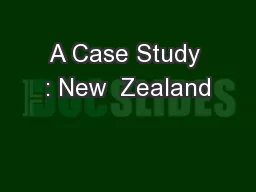

Government Procurement John Ivil General Manager Government Procurement Second South Asia Regional Public Procurement Conference Islamabad Pakistan 2527 March 2014 Key facts amp figures Landmass ID: 643499
Download Presentation The PPT/PDF document "A Case Study : New Zealand" is the property of its rightful owner. Permission is granted to download and print the materials on this web site for personal, non-commercial use only, and to display it on your personal computer provided you do not modify the materials and that you retain all copyright notices contained in the materials. By downloading content from our website, you accept the terms of this agreement.
Slide1
A Case Study :New Zealand Government Procurement
John Ivil, General Manager Government ProcurementSecond South Asia Regional Public Procurement ConferenceIslamabad, Pakistan 25-27 March 2014Slide2
Key facts & figures
Landmass - 268,021 km2Population - 4.4 MillionGovernment
spend
- ~$
30
Billion (16% GDP)
~ 95% of businesses are SMEs
Government agencies
- 200+ (2500 schools)
Agency pareto (85% spend)
- 40
Agencies
Decentralised procurement
No specific procurement legislation –Rules of sourcingSlide3
Transparency and Accountability in New Zealand
Decisions made by government are highly
visible and
transparency is one of the key mechanisms that ensures
government accountability
in New Zealand.
The media,
legislation (such
as the Official Information Act
1982)
and the Public Service Code of Conduct, ensure that the government is accountable and responsive.Slide4
Cost savings
Support value for money
Future Activity
The next steps.....
Machinery of GovernmentSlide5
NZ Government structure
Public Service
State Services
State Sector
Public Sector
Police
Defence
Hospitals
Schools
Post
Electricity
Mining
Universities
Gas
Arts, TV &
Radio
Research
Ministries
Local Councils
Regional CouncilsSlide6
NZ Government Procurement - Context
Very tight fiscal environment - reduce cost and riskCanterbury
rebuild
Culture
of risk aversion in government procurement
A need to professionalise procurement
Shortfall in procurement capability (agency & individual)
Support free trade negotiations
Support economic growth
A need to be fast, agile and flexibleSlide7
Government Procurement Reform -
2009 to 2012
Procurement Functional Leadership (PFL)
– from 2012 until PresentSlide8
Procurement reform – What did it achieve?
Established the business case for change – demonstrated valueCost savings of over NZ $350M Procurement Academy
Encouraged investment in procurement capabilitySlide9
Procurement Functional Leadership
Unlock cost savings
Create environment for NZ businesses to succeed
Increase performance, add value, maximise results
Integrate procurement strategies with government’s objectives
Establish what we buy, how much we spend & with whom
Aggregate areas of common spend
Change buyer behaviour
Develop procurement profession & leadership
Build confidence in government as a trusted partner
Strengthen commercial acumen & build sustainable outcomesBenchmark performance & improve resultsSimplify policy & standardise good practice Make it easy to do business with government Foster relationships responsive to businessStimulate supplier performance - drive efficiency & productivity Seek innovation & increase competitivenessImprove access to international markets
Slide10
confusing procurement policy
35+ policy documents
variable application
excessive focus on compliance
operationally inefficient
strong
leadership
clarify what is expected of agencies
create single policy statement across government
publish in plain English
strengthen leadershippromote change through capability reviews boost education & training
implement standard results measurement
immature profession
few qualified practitioners
limited commercial acumen
variable results
limited strategic capability
inconsistent practice
every agency buys differently
processes unnecessarily complicated
unpredictable, slow & costly for supplier to participate
roll-out practical how-to guides
develop plain English templates
standardise government contracts
opportunities
actions
Increase performance, add value, maximise resultsSlide11
government is an unattractive
customer
difficult
to work with
perception
that lowest price
always
wins
no
incentive for suppliers to improve performancelittle engagement with supplierslack of understanding of business needs
facilitate early market engagementremove barriers & cut red tapepromote a fairer allocation of riskencourage constructive contract management practicesreward innovation & improvement push for payment on timepromote benefits of working with governmentlimited market access trade barriersrestricted export opportunities
align Mandatory Rules with WTO Government Procurement Agreement
negotiate
increased market access for NZ businesses
opportunities
actions
Create environment for NZ businesses to succeedSlide12
inefficient government spend
fragmented spend
information gaps
poor forecasting
lacks strategic approach
expand aggregation of spend (e.g. All of Government contracts)
identify demand management opportunities
encourage strategic planning & require regular
forecasting
opportunitiesactions
Unlock cost savings
Note - circa $350M in cost savings achieved to
date in 14 contact areasSlide13
PFL – what does it really mean?
Capability development highest priorityCentre-led, not centralisationStrong leadership and support – including commercial pool of procurers to help
agencies and
support
for collaborative
opportunities
Recognises the value procurement can add
W
e now strive to deliver great outcomes rather than just good processSlide14
Meeting the needs of
both government
+
suppliers
Reducing costs for government + suppliers: not a zero sum
game
Ensuring government procurers can ‘walk the talk’
Changing a culture developed over generations
The
tightrope – Its never easySlide15
Significant investment in procurement capability
Leadership support & training
Procurement training for non-procurers
Agency capability reviews
Graduate programme
Immigration (MCIPS on Skills Register)
Capability buildingSlide16
Approach – the value addSlide17
Driving collaboration across governmentMBIE manages and/or facilitates a number of collaborative contracts across government.
Syndicated contracts.
Common capability contracts.
All of government contracts.
All of these contracts are openly tendered in the market.Slide18
Establishing minimum standards of procurement practice
The Government Rules of Sourcing came into force in October 2013. They set minimum standards of procurement practice and align with international best practice
.Slide19
Application of the Government Rules of Sourcing
The Government Rules of Sourcing shape the way that agencies approach the market and assess responses.
All agencies
must
have polices in place that incorporate the five
Principles
of government procurement. Slide20
ConclusionMassive amount achieved in
4 years !Currently in phase two (PFL) of a 10 year programmeInspired by achievements in other jurisdictions…..but fast, agile and flexiblePolitical support Cost of Procurement Reform Programme/Procurement Functional Leadership is fiscally neutral
Strong Agency
commitment over 400 agencies participating on a voluntary basis
NZ procurement academy established
From scepticism to
positivity
The key to success is investment in capabilitySlide21
Cost savings
Support value for money
Questions ?